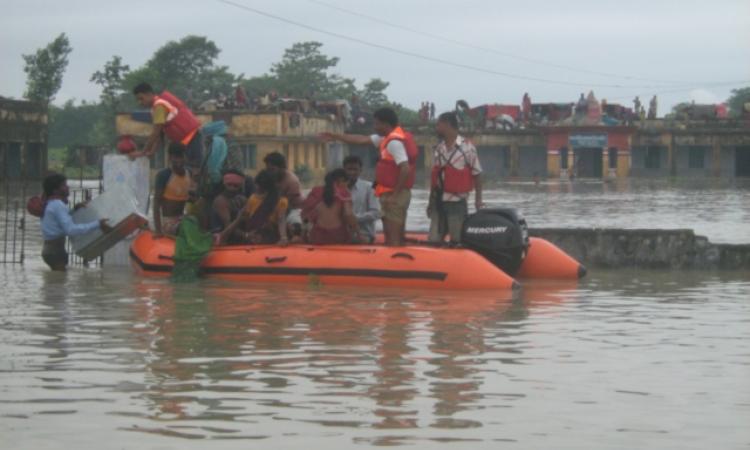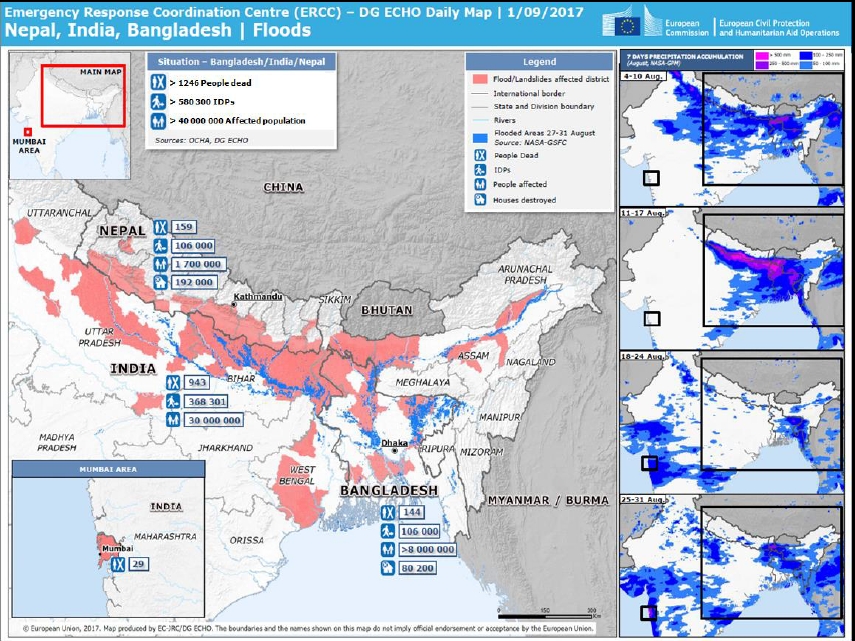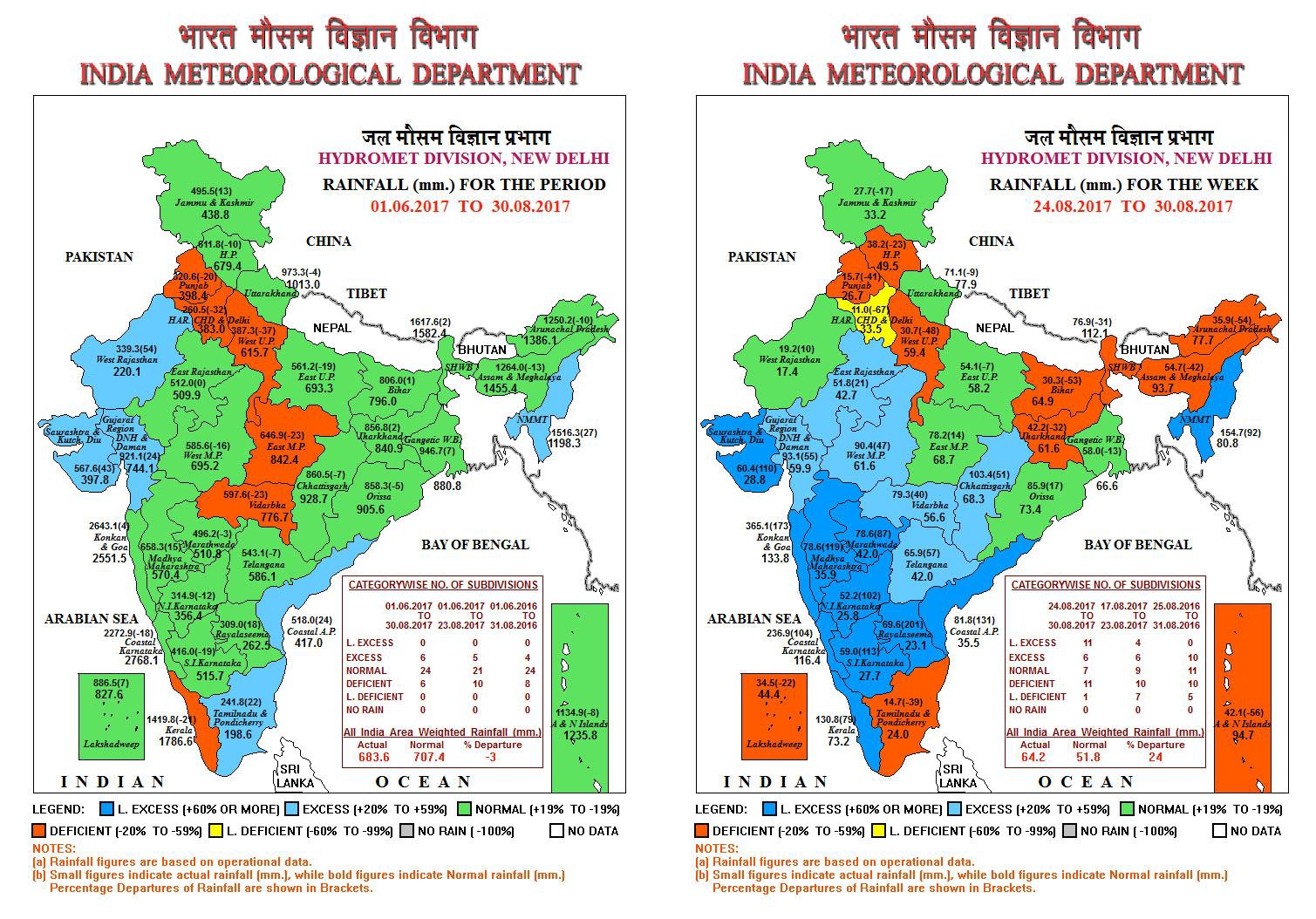
It was supposed to be a normal monsoon as Indian Meteorological Department had predicted. But barring the central plateau, the rest of India may be forgiven for thinking that the Biblical deluge has come a second time. As of September 1, the death toll from flooding stands at 943. More than a million people have been displaced and 32 million affected in some way or the other. Floods had, in fact, begun with the “pre-monsoon showers” in Mizoram, way before we started measuring its effect.
The floods of 2017
The day the monsoon “officially” began, May 30, 2017, was also when the floods claimed their first victims. The northern limit of the monsoon led to flash floods in Phek district of Nagaland killing two farmers. By June 2, the Brahmaputra was flowing above danger level at Nemighat in Assam, a state that was just recovering from the effects of cyclone Mora that had swept across much of the northeast. Since then, Assam has been flood-affected without a pause. As of September 10, 72,000 people across four districts have been impacted by the flood.
In July, Ahmedabad received 828 mm of rainfall, nearly four times the monthly normal of 291 mm. This was the case in nearly all the districts of Gujarat, which led to extensive flooding. The release of water from Dharoi dam exacerbated the flood. July also saw incessant rainfall in Odisha, affecting 28,000 people by the first week of August.
 The lower Gangetic basin has been the worst hit, with large areas of Uttar Pradesh and Bihar remaining flooded for much of the monsoon. By the first week of September, the death toll in Uttar Pradesh had reached 110 people, with three lakh people living in relief camps. In Bihar, 514 people have lost their lives, while 4.2 lakhs are living in relief camps as of September 10. While Jharkhand did not witness any loss of lives, there was some flooding in the state with rivers running in spate and water entering homes.
The lower Gangetic basin has been the worst hit, with large areas of Uttar Pradesh and Bihar remaining flooded for much of the monsoon. By the first week of September, the death toll in Uttar Pradesh had reached 110 people, with three lakh people living in relief camps. In Bihar, 514 people have lost their lives, while 4.2 lakhs are living in relief camps as of September 10. While Jharkhand did not witness any loss of lives, there was some flooding in the state with rivers running in spate and water entering homes.
The Himalayan states have been experiencing heavy rainfall. In July, two people were killed in Himachal Pradesh during a cloudburst. On August 29 and 30, Mumbai flooded. This event, which attracted much media attention, also brought the focus on urban flooding. Eastern Maharashtra however, welcomed the rains as they brought relief from a long standing drought.
Given that the primary focus of overworked rescue workers is to minimise human loss, there is very little information on the impact of these floods on wildlife. In Assam however, the Wildlife Trust of India has been doing stellar work rescuing animals trapped in the Kaziranga floods. They have also set up an emergency relief network in districts of Bihar, Bengal and Assam to provide care to flood-affected animals.
This is the new normal
Given the extensive flooding and the mayhem that the monsoon caused this year, it is astounding that the country did not actually experience a catastrophic amount of rainfall. In fact, there has been three percent deficit in rainfall over the monsoon period. Where there were variations at the local level, only six meteorological divisions received rainfall that was above normal. With the exception of Saurashtra, it is not in these areas of “excess rainfall” that the worst kind of flood happened. Notably, the Gangetic plains had normal or below normal rainfall. 
The matter becomes clearer when we break up this data to look at the intensity of rainfall. A look at the last week of August shows 17 divisions with rainfall greater than 120 percent of the normal. It is then the intensity, rather than the quantum of rainfall that leads to floods. It is only getting worse. One of the chief impacts of climate change in the subcontinent is episodes of intense rainfall. The bursts of heavy rainfall that we see now are not an aberration, but the new normal that needs to be factored into our monsoon planning.
Experts are beginning to question India’s disaster preparedness. In an interview with Deutsche Welle (DW), Nitya Jacob, environmentalist, said, “It is high time we transit quickly to preparedness-centric approach. But in reality, this is not the case, and we continue to be in the relief-centric mode.” India Water Portal had pointed this out two years ago when we said that along with response and relief, we need to add "prevention" into our disaster management plans.
The other question is that of the selection of appropriate technologies. The National Water Policy recommends an emphasis on non-structural flood management practices such as flood forecasting and zoning. These recommendations are largely ignored. In the few cases where states are putting in place a comprehensive flood management programme, several activities have questionable benefits. Assam, for example, has a heavy focus on the construction of embankments and “river training”. This has been proven to be counterproductive leading to an increase in the intensity of floods, environmental damage and increase in societal vulnerabilities. Dinesh Mishra, who has been campaigning extensively for a more nuanced approach to flood management, considers the focus on embankments an example of technological hubris that has alienated the people who live along the river.
This focus on infrastructure seems ill-advised the more we consider urban floods. People were fishing on the streets of Bangalore in July, after a lake overflowed following rainfall of 96 mm in 72 hours. In August, 315 mm of rain in Mumbai in 24 hours brought the city to a standstill and caused several deaths. That should not happen in a coastal city where the annual average rainfall is 2400 mm. However, inadequate provision of stormwater drains, destruction of natural watershed and removal of buffers such as the mangroves have resulted in an absolute lack of resilience to an annual phenomenon. The Bandra-Worli sea link narrowed the mouth of the Mithi river, the city cannibalised its wetlands and the protecting mangroves were annihilated by the time floods hit in 2005. Despite that, even a decade later, nothing has been done to redress these problems. The result? Two days of heavy rain this year killed 14 people in the city alone.
What happens next?
The country may feel relieved as the rains finally abate. But the flood-affected people will continue to face bigger challenges. Very few of the one million people who have been displaced by the floods have homes to go back to. In addition, large areas will remain inundated especially where embankments will prevent the return of floodwaters to the river. Various diseases will break out soon. Organisations involved in relief work in Bihar carried out a joint needs assessment at the end of August 2017. The assessment reveals the dismal state of water and sanitation. Almost 96 percent of drinking water sources are contaminated. Providing water in tankers is also not the solution since only 10 percent of households have a facility for safe storage of water. This, combined with open defecation due to floods, heralds a massive outbreak of disease soon. Further, rehabilitation also poses a challenge since 63 percent of the people surveyed have lost their identification documents. This is critical for identification and access to aid.
What can we do about this?
Given that climate change, increasing population and urbanisation are all realities, it is reasonable to expect that intense rainfall and flooding will be present in our lives. However, people and animals need not die due to floods. The primary measure to reduce the loss of lives and property from floods is to have an adequate flood forecasting and warning system in place. India is sadly deficient on both fronts.
The Central Water Commission has 175 flood monitoring stations across nine river basins. However, a report by the Comptroller and Auditor General of India on flood forecasting revealed that of the 219 telemetry stations (recording and transmitting readings of the flood forecasting instrument) between 2012 and 2017, only 56 had been installed as of August 2016. Of these, nearly 60 percent were non-functional. There is also a lack of transparency regarding the dissemination of these forecasts. A report by the National Institute of Disaster Management reveals that in case of flood warnings, forecasts are “disseminated to users agencies, such as civil/ engineering authorities of concerned states, defence, railways/ highways authorities, industrial and other important establishments located in the flood prone areas through telephone/fax/ e-mail/ special messenger”.
This does not always translate to last-mile early warnings which reach the flood-affected communities in the shortest time possible. David Molden, the director general of International Centre for Integrated Mountain Development (ICIMOD), recommends a focus on community-level monitoring and warning systems. He says, “For the really localised flash floods, people can employ some homemade gadgets. One such example being used in Assam is a device that detects the water level in a stream. When the water level goes up, it sends out a signal to an alarm or a telephone system.”
Besides flood forecasting, the capacity of areas to absorb floods can be enhanced by protecting and encouraging natural systems such as mangroves, wetlands and coastal reefs. India already has policies in place for the conservation of these ecosystems. It now remains to be recognised that these are essential to the survival of human populations and undertake their conservation with the seriousness presently reserved for the construction of embankments.
Here, we take a look at what awaits the flood affected as the water recedes.